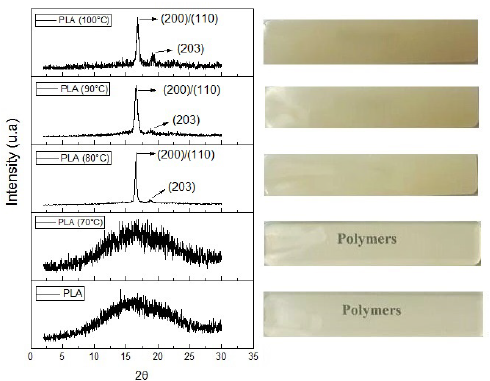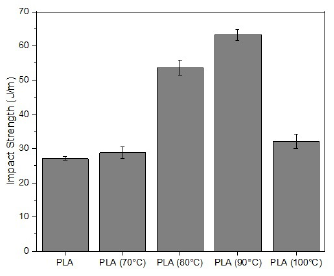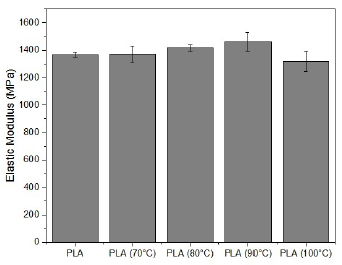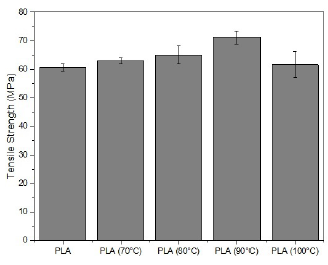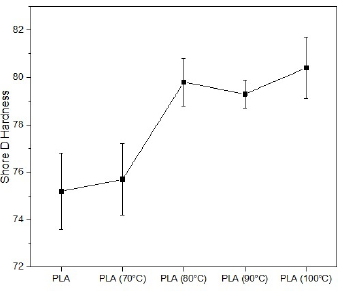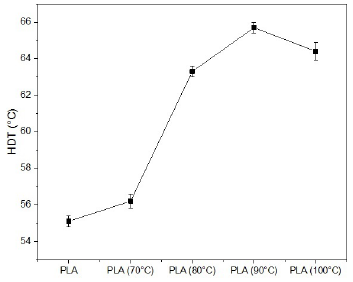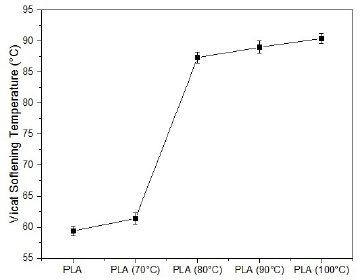Introduction
During the last 50 years, petroleum-based polymers have been widely used, due to the versatility, proper mechanical properties and relatively low cost [1]. However, the improper disposal of polymer products together with industrial pollution have seriously damaged our ecosystem [2]. Trying to solve or at least diminish these harmful residues, scientists and researchers have directed attention to find solutions for sustainable methods, with the development of "green technologies" through the production of biodegradable polymers such as poly (hydroxybutyrate) (PHB), poly (e-caprolactone) (PCL) and poly (lactic acid) (PLA) [3, 4].
PLA has aroused great interest in industrial applications, since it is a biopolymer with biodegradable character [5]. PLA is aliphatic, thermoplastic, semicrystalline polyester, synthesized from lactic acid from renewable sources such as corn, wheat and sugar cane [6]. The mechanical properties of PLA are comparable to those of polymers from fossil sources, even presenting high rigidity and transparency, when in the amorphous state [7]. Currently, PLA is widely used in 3D printing technology, since it is environmentally friendly and has high printing speed, with smoother and shiny surface, as well as provides the possibility of producing complex detailed piece [8]. However, PLA has high fragility and low thermomechanical stability, making its use unfeasible in parts where impact strength and dimensional stability are requested at high temperatures [9]. Therefore, currently PLA has often to be modified to reach the market specifications [10]. The annealing as a heat treatment is one of the main methods to modify PLA, at relatively low cost it directs to adjustable properties on PLA pieces [11].
Annealing consists to submit the polymer at defined temperature between the glass transition (Tg) and the melting temperature (Tm) for a specified time. The degree of changes depends on the applied temperature and annealing time, generally this procedure purposes to relieve stress concentration, changing crystallite dimensions, accelerating crystallization or developing new crystalline phases [12-14].
Tabi et al. [15] carried out investigation on PLA crystallization under annealing at 60, 80, 100, 120 and 140 oC using distinct time intervals, ranging between 10 and 60 minutes. Acquired results from X-ray diffraction showed that annealing at 100-140 oC for 10 minutes was enough to reach the high crystallinity on PLA, i.e., approximately 40%. Differential scanning calorimetry (DSC) scans displayed intense exothermic peak in the range 80-140 oC, which was related to cold crystallization, which had intensity decreased upon annealing, and no exothermic peak was observed for longer annealed samples ( ~ 40% crystalline), suggesting complete crystalline phase.
Srithep et al. [16] evaluated annealing effects on the crystallinity of injected PLA specimens. DSC scans, tensile properties and dynamic-mechanical (DMA) analyses presented increase in PLA crystallinity upon annealing which provided considerable benefits such as a higher Tg, higher thermal stability, higher tensile strength and storage module. Increase higher than 17% and 26 % on tensile strength were reported for annealed PLA at 80 oC for 30 min and at 65 oC for 1 h, respectively.
Pereira and Morales [17] investigated the annealing influence in PLA at 105 oC for 90 minutes, as acquired data, the degree of crystallinity increased up to 44 %, rendering increased HDT and VST. Nevertheless, lower mechanical performance was obtained, authors suggested that applied annealing parameters were harmful do PLA and probably conducted to degradation.
Thermal treatment has been investigated in PLA focused on its crystallization behavior; however there is lack of works based on PLA mechanical performance, tensile properties as well on impact strength. From these perspectives researches aiming to elucidate the best thermal treatment to produce high mechanical performance PLA should be welcome for the scientific and the technological communities.
Therefore, this work aimed to investigate the influence of the annealing at 70, 80, 90 and 100 oC on PLA injected specimens, emphasizing mechanical properties, such as tensile strength, impact strength and Shore D hardness, thermomechanical (HDT and VST) and crystallinity (XRD).
Methodology
Materials
Polyacid lactic (PLA) coded 2003D, melt flow rate (MFR) 6 g/10 min (210 oC/2.16 kg), as pellets was purchased from Ingeo.
Methods
Injection molding
Specimens were injection molded using an Arburg Model Allrounder 207C Golden Edition injector, applying informed parameters in Table 1. Specimens for impact strength, tensile and HDT were processed according to ASTM D256, D638 (Type I) and D648, respectively.
Thermal Aging
Specimens were thermal aged in a vacuum oven at 70, 80, 90 and 100 oC, for 6 hours, afterwards the oven was turned off and specimen were let down cooling to the ambient temperature.
Characterizations
X-ray diffraction analysis (XRD) was performed using a Shimadzu XRD-7000 diffractometer, with copper Ka radiation, 40 kV voltage, 30 mA current, 29 scanning ranging from 2 to 30 o and scanning rate 2 o/min.
Izod impact strength test was performed on notched specimens, according to ASTM D256, in a Resil 5.5 J from Ceast, operating with hammer of 2.75 J, at room temperature (~ 23 oC). Presented results are average of seven specimens.
Tensile test carried out with injected specimens according to ASTM D638 using an EMIC DL 2000 universal test machine with elongation rate of 5 mm/min and load cell of 20 kN at room temperature (~ 23 oC). Presented results are average of seven specimens.
Hardness test was performed according to ASTM D2240 in Shore-Durometer Hardness Type "D" with 50 N load controlled by calibrated springs through durometer standardized indices. Results were analyzed with an average of seven measurements.
The penetration resistance was determined according to the ASTM D2240 standard, on a Shore "D" durometer, with a load of 50 N controlled by springs calibrated by means of standardized indenters for the durometer. The results were analyzed with an average of seven penetrations.
Heat deflection temperature (HDT) was performed according to ASTM D648 in a Ceast HDT 6 VICAT model with voltage of 1.82 MPa and heating rate of 120 oC/h. The temperature was determined after the specimen deflecting 0.25 mm. Presented results are average of three specimens.
Vicat softening temperature (VST) test was performed according to ASTM D1525 in a Ceast model HDT 6 VICAT using a heating rate of 120 oC/h and load of 50N. The temperature was determined after the needle penetrating 1 mm into the specimens. Results were analyzed with an average of three specimens.
The penetration resistance was determined according to the ASTM D2240 standard, on a Shore "D" durometer, with a load of 50 N controlled by springs calibrated by means of standardized indenters for the durometer. The results were analyzed with an average of seven penetrations.
Heat deflection temperature (HDT) was performed according to ASTM D648 in a Ceast HDT 6 VICAT model with voltage of 1.82 MPa and heating rate of 120 oC/h. The temperature was determined after the specimen deflecting 0.25 mm. Presented results are average of three specimens.
Vicat softening temperature (VST) test was performed according to ASTM D1525 in a Ceast model HDT 6 VICAT using a heating rate of 120 oC/h and load of 50N. The temperature was determined after the needle penetrating 1 mm into the specimens. Results were analyzed with an average of three specimens.
Results and Discussion
X-Ray Diffraction
Figure 1 presents XRDs X-ray diffractograms and optical images collected from PLA specimens surface, before and after the annealing treatment. Related to XRDs, before thermal treatment, PLA displayed wide band ranging from 5 to 30o, typically of amorphous material, upon annealing at 70 oC, no significant change was verified, however, at higher temperatures, i.e., 80, 90 and 100 oC, an intense and well-defined crystalline peak was observed, at 2θ = 16.79o, due to the crystalline diffraction planes (200) or (110), a smaller peak at 2θ = 18.98o was also observed which is associated with the plane (203), characteristic peak of α phase, as previously reported [18]. From the melting and crystallization, the typical PLA a phase is originated with an orthorhombic crystalline cell and a = 1.066 nm, b = 0.616 nm and c = 2.888 nm parameters [19].
Superficial modifications on PLA specimens upon annealing were followed through photographic images emphasizing the level of transparency and opacity. In Figure 1, PLA specimens before annealing and annealed at 70 oC are transparent, clearly showing the written world Polymers on the paper. In these specimens the incident light beam is transmitted without deflection to the upper surface, typically verified on amorphous materials, and corroborating DRXs. PLA specimens annealed at 80, 90 and 100 oC were opaque, and Polymers word are not visible anymore. The degree of opacity is mainly influenced by the degree of crystallinity, since the transmitted light is deflected among the contours of the crystalline regions [20]. Apparently, the annealing at 100 oC severely affected the opacity, with darker shade, most likely, due to crystallites able to scatter the light, as well as due to degradation reactions taking place on the specimen surface and core.
XRD testing may be applied to evaluate the crystallinity of polymers, where the diffractogram can be divided into two distinct areas, one related to the crystallinity and the other to the amorphous halo. In this work, the Ruland Equation (Eq. 1) was used to measure the degree of crystallinity on PLA specimens [21]:
Where: Ic corresponds to the integration of the crystalline peaks.
Ia is the integrated area of the amorphous halo integration. K is a characteristic polymer constant, for PLA it is 1.0 [22].
The degree of crystallinity of PLA specimens as evaluated using Eq. 1 is presented in Table 2. Annealing temperatures are indicated.
TABLA 2 Degree of crystallinity of PLA specimens computed from XRD and using Ruland equation. Annealing temperatures indicated.
| Specimens | Degree of Crystallinity* |
|---|---|
| PLA | Amorphous |
| PLA (70 oC) | Amorphous |
| PLA (80 oC) | 47.1% |
| PLA (90 oC) | 61.5% |
| PLA (100 oC) | 39.2% |
*Crystallinity was determined through numerical integration of the peak area using OriginPro 2018(g) software.
Table 2 shows that the heat treatment strongly influences the degree of crystallinity, suggesting structural organization on annealed PLA. As the temperature increased from 80 to 90 oC, considerable increase, 30%, in the crystallinity was verified, apparently, improving microstructure ordering, possibly due to the crystallites' lamellar thickening [23]. However, opposite behavior occurred in PLA annealed at 100 oC, the degree of crystallinity decreased 36 % which might be associated to the degradation starting conducting to smaller and imperfect crystals [24].
Impact Strength
Figure 2 shows impact strength results of PLA before and after annealing at 70, 80, 90 and 100 oC. The non-annealed PLA showed low impact strength, i.e., 27 J/m, indicating fragile behavior and poor energy dissipation mechanism. Annealing at 70 oC was not effective to increase impact, since it presented similar data to that of non-annealed PLA, this result is opposed to that verified by Yu et al. [25], who reported that annealed PLA at 70 oC significantly increased elongation at break and impact strength; nevertheless, those authors carried out experiments with PLA films while in the present work injected specimens were tested, hence, processing parameters should be counted as well as samples thickness.
Upon annealing at 80 and 90 oC significant increase was obtained in impact which reached 97.8 and 133.2%, higher than non-annealed PLA, respectively. This increase is viewed as technological contribution, since one of the major PLA limitations is its low impact strength. In general, increase in crystallinity leads to denser and brittle polymers and consequently, lower impact [25, 26]. However, this assumption is not valid for the reported data in the present work, whereas crystallinity and impact increased, despite not usual, such behavior was also already reported [11-27].
PLA toughening mechanisms upon annealing is not clear in the literature. Park et al. [28] suggested that the spreading crack when meets the spherulite would provide a distribution of tensions, in this sense, the phenomenon of micro cracking would occur along the spherulite interface, enabling the energy distribution before the catastrophic crack, contributing for the impact strength increase. Apparently, 90 oC is the ideal temperature for PLA annealing, as at 100 oC impact reduction was verified.
Tensile Properties
Elastic modulus of PLA before and after annealing is presented in Figure 3, as an important parameter for practical applications it indicates the material resistance to the elastic deformation. Non-annealed PLA presented elastic modulus of 1370 MPa, while the highest performance was 1461 MPa for annealed PLA at 90 oC. In the investigated temperature range (70 to 90 oC) the elastic modulus only subtly changed, if considering the experimental error margin, similar data were obtained. Nevertheless, annealed PLA at 100 oC trended to lower performance most due to the degradation as originated from aggressive annealing. Similar behavior was already reported for PLA upon annealing at 105 oC during 90 minutes. [17]
Annealing at 90 oC may be seen as technologically relevant for the mechanical properties improvement of PLA, since it increased the stiffness and, at the same time, considerably increased the impact strength.
Figure 4 shows the tensile strength of PLA before and after annealing at 70, 80, 90 and 100 oC. Before annealing PLA displayed tensile strength of 60 MPa, which is relatively high parameter when compared to commodity polymers such as PP and PCL [29-31]. Upon annealing at 70, 80 and 100 oC no significant increase was verified relate to non-annealed PLA, whereas annealing at 90 oC provided higher tensile strength, i.e., 71.2 MPa, which is probably due to the higher crystallinity as presented in the XRD data. Apparently, annealing at 90 oC is the ideal temperature for PLA, generating more perfect crystallites as well as higher concentration of inter-crystals connections, contributing to withstand higher stresses under tensile tension [32].
Shore D hardness
Shore D hardness represents the resistance into the surface penetration of specific material, being a fast and non-destructive experiment which allows evaluating modifications on products (thermally, mechanically etc). Figure 5 shows PLA Shore D hardness as function of annealing, at 70 oC PLA this parameter was not altered corroborating with DRX, suggesting unchanged amorphous region. At higher annealing temperatures, i.e., 80, 90 and 100 oC increase in Shore D hardness was verified most due to the densification mechanisms. The increase in hardness can be assumed as indication of structural modification, i.e., from the amorphous to the crystalline state, as also verified through DRX. Indeed, higher crystallinity means severer barrier to penetrate the crystalline surface [33, 34]. Quite similar results were collected applying the annealing temperatures 80 and 90 oC due to similar surface hardness.
Heat Deflection Temperature (HDT)
HDT indicates the dimensional stability of polymeric materials when submitted to sob-ambient temperatures [35]. PLA HDT as function of annealing temperature is displayed in Figure 6. HDT of non-annealed PLA is 55 oC, upon annealing at 70 oC HDT subtly increased to 56.2 oC; and significantly increased after annealing at 80, 90 and 100 oC, this behavior indicates PLA's HDT is strongly influenced by the degree of crystallinity. Similarly, the literature reported that HDT increases with stiffness and degree of crystallinity, however there is an optimum annealing temperature to improve these properties [17, 36]. In this work PLA annealing treatment at 80 and 100 oC, almost did not modify the HDT. Contrarily, annealing at 90 oC, increased HDT by 20 % related to non-annealed PLA. The HDT results indicate that annealing is favorable for PLA parts molded using 3D printing, mainly at 90 oC, as it improves the resistance to distortion, this finding becomes important from a scientific, technological and industrial point of views, since one of the main limitations of PLA is its low dimensional thermal stability.
Vicat Softening Temperature (VST)
VST testing was used as qualitative indicator of PLA thermomechanical behavior when submitted to constant load and heating rate. Figure 7 shows VST results as function of annealing temperatures, as illustrated non-annealed PLA presented VST of 59.5 oC, which it was similar after annealing at 70 oC. Upon annealing at 80, 90 and 100 oC, VST increased around 30 oC related to non-annealed PLA, this increase is assumed to be linked to the higher degree of crystallinity, as seen through DRX data. In addition, it may also be related with the crystals growth which typically takes place during PLA annealing [37].
Conclusions
Annealing is a suitable methodology to model PLA seeking to attain desired properties mainly on injection molded or 3D printing products. The temperature of 90 oC may improve impact strength, Shore D hardness, HDT, VST and tensile strength, while keeping the elastic modulus. These properties are maximized due to the PLA morphological modification, i.e., from the amorphous to the crystalline state. Optical properties are also modified since PLA specimens go from transparent to opaque ones. Presented results are important for the industry and polymer technology, since a quite simple procedure can greatly improve PLA properties.













